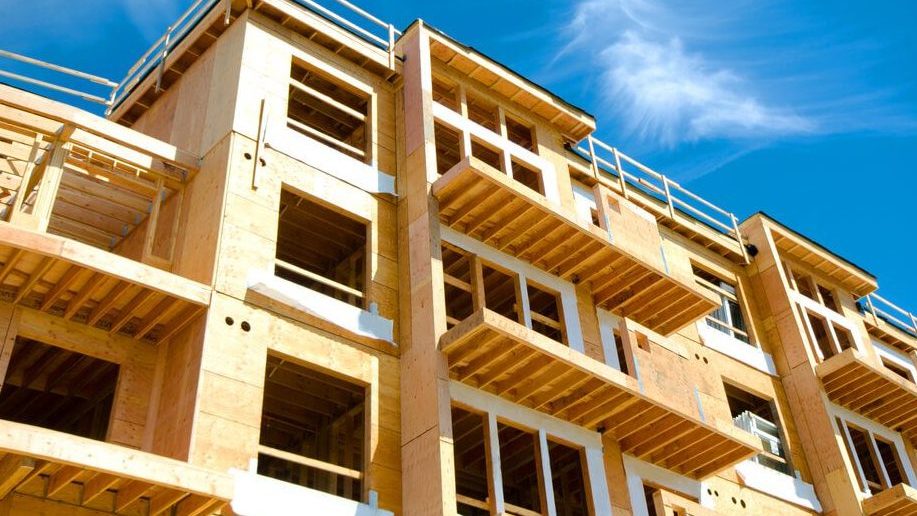U.S. Residential Construction Permits Reach 12-Year High

Low interest rates, tight markets and solid consumer confidence has U.S. builders constructing more homes than they have in at least a decade.
U.S. building permits and housing starts increased for both single-family homes and multifamily developments in October, according to the latest U.S. Census figures. The seasonally adjusted annual rate (SAAR) for annual multifamily (5+) starts rose by 6.8% from September and were up 10.7% year-over-year. Likewise, the 505,000 multifamily units permitted in the year-ending October 2019 were up for the month (6.1%) and over the past year (27.5%). Meanwhile, the less-volatile single-family industry saw starts increase 2% over September and 8.2% from last year, while single-family permits (909,000 units) rose 3.2% for the month and 7.4% for the year.
The 505,000 multifamily units permitted in the past year is only the fifth time in the past decade that permitting levels surpassed a half-million units.
Together, total residential building permits hit a 12-year high at 1.46 million units and total residential starts approached August’s peak with a strong 1.31 million units.
Multifamily permitting has averaged close to 430,000 units annually since 2015, but that total has swung widely between 300,000 and 600,000 units. Multifamily starts are just as volatile, but tend to have a lower annual average since multifamily permits include condominiums and other projects that are not in the starts survey. Just over the past 12 months, seasonally adjusted annual multifamily permits have averaged 455,000 units while multifamily starts have averaged 364,000 units.
With the higher annual rates over the past few months, total residential permitting levels have exceeded 1.3 million units in seven of the previous 12 months and have reached above 1.4 million units twice in the past three months. Total residential starts averaged 1.2 million units in the past 12 months, while single-family starts averaged 865,000 units. Multifamily completions were up 27.3% from September at 354,000 units, and were 25.5% higher than October 2018.

Looking at regional performances, multifamily building permits were up in most regions of the country on an annual basis, except for the Midwest, where approvals contracted by 28.5%, falling to 45,000 units. Each of the remaining three regions saw double-digit percentage increases. Numerical upturns were at about 22,000 to 28,000 units in the Northeast and West and more than 77,000 units in the South.
Multifamily starts were down in the Midwest (-15.4%) and South (-10.7%) regions, but were up sharply in the West (+33.3%) and the much smaller – and therefore more volatile – Northeast (232% from an extremely weak October 2018). Regionally, multifamily completions were down or flat in the Midwest and South, but up by nearly 80% in the Northeast and West.
At the metro level, all but one of last month’s top 10 permitting metros remained the same with only a few changing places. The top seven returned in order. New York, Houston and Dallas held onto the top three rankings, with roughly 20,000 to 38,000 units approved. Seattle, Washington, DC, Los Angeles, and Austin permitted close to 14,000 units apiece in the #4 through #7 spots. Orlando and Minneapolis-St. Paul switched places at #8 and #9 with close to 11,000 units permitted, while Charlotte displaced Atlanta at the #10 spot. Atlanta fell to #16.

Eight of the top 10 markets experienced increases in annual multifamily permitting from last year, as only Seattle and Los Angeles saw a decline permits (-357 and -666 units, respectively). The remaining top 10 markets saw increases in permitting from 7.3% to 77.8%. In net units, Houston permitted more than 10,000 more multifamily units than the preceding 12 months while New York permitted about 7,100 more units than last year. Washington, DC jumped almost 3,200 units and Minneapolis-St. Paul and Austin logged about 1,800 units greater than their previous annual totals. Dallas, Orlando, and Charlotte were between 632 and 1,335 units higher than last year.
Other markets that saw significant increases in annual multifamily permitting in the year-ending October were Tampa (+5,340), Salt Lake City (+3,510), Jacksonville, FL (+2,145) and San Antonio (+1,886).
A few small markets saw a surge in permitting such as Bridgeport-Stamford-Norwalk, CT which went from 231 multifamily units permitted through October 2018 to 1,790 units this year. Other small market contenders included: Palm Bay, FL (381 units to 1,448 units) and Wilmington, NC (473 units to 1,579 units).
On the other hand, significant slowing (-1,500 or more) occurred in Oakland, Raleigh/Durham, Atlanta, and San Diego. Memphis’ annual total through October fell from 1,590 units in 2018 to 343 units in 2019.
The annual total of multifamily permits issued in the top 10 metros – 166,174 units – was 18.4% greater than the 140,758 approvals issued in the previous 12 months. The total number of permits issued in the top 10 metros was almost equal to the number of permits issued for the #11 through #38 ranked metros.
The list of top individual permitting places (cities, towns, boroughs, and unincorporated counties) generally include the principal city of some of the most active metro areas. Much like the top 10 metro list, the top 10 permitting place list includes many of the same 10 cities or permit-issuing places as last month. The city of Houston again led the nation for the year-ending October, with the city of Austin moving back into the #2 spot and Unincorporated Harris County (Houston) slipping to #3. Charlotte’s Mecklenburg County, and the city of Washington again round out the top five.

Of the top permit-issuing places (cities or counties), the metro areas in Charlotte, Chicago, San Francisco, Denver, San Antonio and Nashville did not make the top 10 list for permits by metro. Consistently placing in the top three for metro-level permitting, New York and Dallas had no permit issuing places in the top 10 as their apartment development pattern is more spread out among their suburbs.






